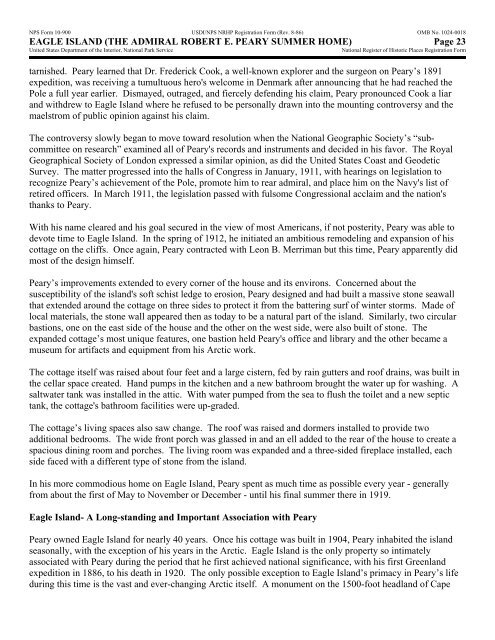Nomination - National Park Service
Nomination - National Park Service
Nomination - National Park Service
You also want an ePaper? Increase the reach of your titles
YUMPU automatically turns print PDFs into web optimized ePapers that Google loves.
NPS Form 10-900 USDI/NPS NRHP Registration Form (Rev. 8-86) OMB No. 1024-0018<br />
EAGLE ISLAND (THE ADMIRAL ROBERT E. PEARY SUMMER HOME) Page 23<br />
United States Department of the Interior, <strong>National</strong> <strong>Park</strong> <strong>Service</strong><br />
<strong>National</strong> Register of Historic Places Registration Form<br />
tarnished. Peary learned that Dr. Frederick Cook, a well-known explorer and the surgeon on Peary’s 1891<br />
expedition, was receiving a tumultuous hero's welcome in Denmark after announcing that he had reached the<br />
Pole a full year earlier. Dismayed, outraged, and fiercely defending his claim, Peary pronounced Cook a liar<br />
and withdrew to Eagle Island where he refused to be personally drawn into the mounting controversy and the<br />
maelstrom of public opinion against his claim.<br />
The controversy slowly began to move toward resolution when the <strong>National</strong> Geographic Society’s “subcommittee<br />
on research” examined all of Peary's records and instruments and decided in his favor. The Royal<br />
Geographical Society of London expressed a similar opinion, as did the United States Coast and Geodetic<br />
Survey. The matter progressed into the halls of Congress in January, 1911, with hearings on legislation to<br />
recognize Peary’s achievement of the Pole, promote him to rear admiral, and place him on the Navy's list of<br />
retired officers. In March 1911, the legislation passed with fulsome Congressional acclaim and the nation's<br />
thanks to Peary.<br />
With his name cleared and his goal secured in the view of most Americans, if not posterity, Peary was able to<br />
devote time to Eagle Island. In the spring of 1912, he initiated an ambitious remodeling and expansion of his<br />
cottage on the cliffs. Once again, Peary contracted with Leon B. Merriman but this time, Peary apparently did<br />
most of the design himself.<br />
Peary’s improvements extended to every corner of the house and its environs. Concerned about the<br />
susceptibility of the island's soft schist ledge to erosion, Peary designed and had built a massive stone seawall<br />
that extended around the cottage on three sides to protect it from the battering surf of winter storms. Made of<br />
local materials, the stone wall appeared then as today to be a natural part of the island. Similarly, two circular<br />
bastions, one on the east side of the house and the other on the west side, were also built of stone. The<br />
expanded cottage’s most unique features, one bastion held Peary's office and library and the other became a<br />
museum for artifacts and equipment from his Arctic work.<br />
The cottage itself was raised about four feet and a large cistern, fed by rain gutters and roof drains, was built in<br />
the cellar space created. Hand pumps in the kitchen and a new bathroom brought the water up for washing. A<br />
saltwater tank was installed in the attic. With water pumped from the sea to flush the toilet and a new septic<br />
tank, the cottage's bathroom facilities were up-graded.<br />
The cottage’s living spaces also saw change. The roof was raised and dormers installed to provide two<br />
additional bedrooms. The wide front porch was glassed in and an ell added to the rear of the house to create a<br />
spacious dining room and porches. The living room was expanded and a three-sided fireplace installed, each<br />
side faced with a different type of stone from the island.<br />
In his more commodious home on Eagle Island, Peary spent as much time as possible every year - generally<br />
from about the first of May to November or December - until his final summer there in 1919.<br />
Eagle Island- A Long-standing and Important Association with Peary<br />
Peary owned Eagle Island for nearly 40 years. Once his cottage was built in 1904, Peary inhabited the island<br />
seasonally, with the exception of his years in the Arctic. Eagle Island is the only property so intimately<br />
associated with Peary during the period that he first achieved national significance, with his first Greenland<br />
expedition in 1886, to his death in 1920. The only possible exception to Eagle Island’s primacy in Peary’s life<br />
during this time is the vast and ever-changing Arctic itself. A monument on the 1500-foot headland of Cape
















